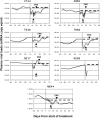Use of a small molecule CCR5 inhibitor in macaques to treat simian immunodeficiency virus infection or prevent simian-human immunodeficiency virus infection
- PMID: 14623909
- PMCID: PMC2194125
- DOI: 10.1084/jem.20031266
Use of a small molecule CCR5 inhibitor in macaques to treat simian immunodeficiency virus infection or prevent simian-human immunodeficiency virus infection
Abstract
Human immunodeficiency virus type 1 (HIV-1) fuses with cells after sequential interactions between its envelope glycoproteins, CD4 and a coreceptor, usually CC chemokine receptor 5 (CCR5) or CXC receptor 4 (CXCR4). CMPD 167 is a CCR5-specific small molecule with potent antiviral activity in vitro. We show that CMPD 167 caused a rapid and substantial (4-200-fold) decrease in plasma viremia in six rhesus macaques chronically infected with simian immunodeficiency virus (SIV) strains SIVmac251 or SIVB670, but not in an animal infected with the X4 simian-human immunodeficiency virus (SHIV), SHIV-89.6P. In three of the SIV-infected animals, viremia reduction was sustained. In one, there was a rapid, but partial, rebound and in another, there was a rapid and complete rebound. There was a substantial delay (>21 d) between the end of therapy and the onset of full viremia rebound in two animals. We also evaluated whether vaginal administration of gel-formulated CMPD 167 could prevent vaginal transmission of the R5 virus, SHIV-162P4. Complete protection occurred in only 2 of 11 animals, but early viral replication was significantly less in the 11 CMPD 167-recipients than in 9 controls receiving carrier gel. These findings support the development of small molecule CCR5 inhibitors as antiviral therapies, and possibly as components of a topical microbicide to prevent HIV-1 sexual transmission.
Figures




Similar articles
-
Effect of a CCR5 inhibitor on viral loads in macaques dual-infected with R5 and X4 primate immunodeficiency viruses.Virology. 2004 Oct 10;328(1):19-29. doi: 10.1016/j.virol.2004.07.021. Virology. 2004. PMID: 15380354
-
Protection of macaques from vaginal SHIV challenge by an orally delivered CCR5 inhibitor.Nat Med. 2005 Dec;11(12):1293-4. doi: 10.1038/nm1321. Epub 2005 Nov 6. Nat Med. 2005. PMID: 16273102
-
V3 loop-determined coreceptor preference dictates the dynamics of CD4+-T-cell loss in simian-human immunodeficiency virus-infected macaques.J Virol. 2005 Oct;79(19):12296-303. doi: 10.1128/JVI.79.19.12296-12303.2005. J Virol. 2005. PMID: 16160156 Free PMC article.
-
Protection of macaques from vaginal SHIV challenge by vaginally delivered inhibitors of virus-cell fusion.Nature. 2005 Nov 3;438(7064):99-102. doi: 10.1038/nature04055. Epub 2005 Oct 30. Nature. 2005. PMID: 16258536
-
Animal models for microbicide safety and efficacy testing.Curr Opin HIV AIDS. 2013 Jul;8(4):295-303. doi: 10.1097/COH.0b013e328361d096. Curr Opin HIV AIDS. 2013. PMID: 23698560 Free PMC article. Review.
Cited by
-
HIV transmission: closing all the doors.J Exp Med. 2004 Apr 19;199(8):1037-40. doi: 10.1084/jem.20040426. Epub 2004 Apr 12. J Exp Med. 2004. PMID: 15078894 Free PMC article. Review. No abstract available.
-
Preferential use of CXCR4 by R5X4 human immunodeficiency virus type 1 isolates for infection of primary lymphocytes.J Virol. 2005 Feb;79(3):1480-6. doi: 10.1128/JVI.79.3.1480-1486.2005. J Virol. 2005. PMID: 15650174 Free PMC article.
-
Pharmacokinetic and Pharmacodynamic Evaluation following Vaginal Application of IQB3002, a Dual-Chamber Microbicide Gel Containing the Nonnucleoside Reverse Transcriptase Inhibitor IQP-0528 in Rhesus Macaques.Antimicrob Agents Chemother. 2015 Dec 14;60(3):1393-400. doi: 10.1128/AAC.02201-15. Antimicrob Agents Chemother. 2015. PMID: 26666935 Free PMC article.
-
Virus-specific T cell responses in macaques acutely infected with SHIV(sf162p3).Virology. 2007 Jun 20;363(1):36-47. doi: 10.1016/j.virol.2007.01.010. Epub 2007 Feb 16. Virology. 2007. PMID: 17307212 Free PMC article.
-
Retrocyclin RC-101 blocks HIV-1 transmission across cervical mucosa in an organ culture.J Acquir Immune Defic Syndr. 2012 Aug 15;60(5):455-61. doi: 10.1097/QAI.0b013e318258b420. J Acquir Immune Defic Syndr. 2012. PMID: 22592582 Free PMC article.
References
-
- Wyatt, R., and J. Sodroski. 1998. The HIV-1 envelope glycoproteins: fusogens, antigens, and immunogens. Science. 280:1884–1888. - PubMed
-
- Berger, E.A., P.M. Murphy, and J.M. Farber. 1999. Chemokine receptors as HIV-1 coreceptors: roles in viral entry, tropism, and disease. Annu. Rev. Immunol. 17:657–700. - PubMed
-
- Doms, R.W. 2001. Chemokine receptors and HIV entry. AIDS. 15:S34–S35. - PubMed
-
- Dragic, T. 2001. An overview of the determinants of CCR5 and CXCR4 co-receptor function. J. Gen. Virol. 82:1807–1814. - PubMed
Publication types
MeSH terms
Substances
Grants and funding
LinkOut - more resources
Full Text Sources
Other Literature Sources
Research Materials

